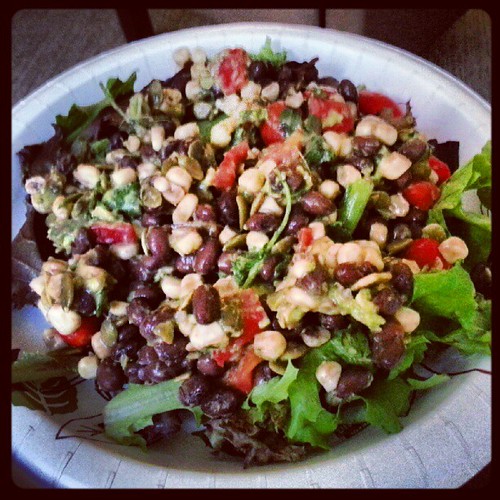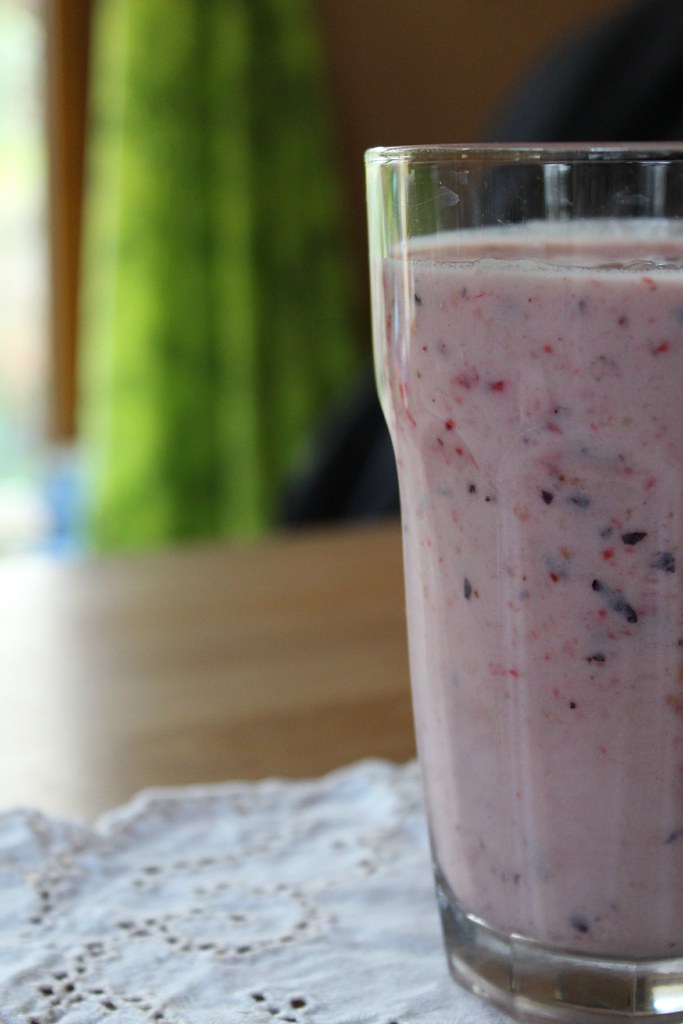The following are some basic principles and shortcuts that may be helpful to those wanting to eat a nutrient dense
mostly plant based diet. My schedule is hectic, so I spent my summer vacation trying to figure out how I could continue to eat healthy in a hurry.
What works best for me is
having a base recipe, and then using variations so I don't get bored.
Breakfast Base - Quick and Delicious Smoothies and Hot Cereal
There is no reason you can't have an AMAZINGLY delicious breakfast daily.
Almost everyday I make a smoothie for breakfast. I have found the tool I use the most often in the kitchen these days is my Ninja, especially the Nutri Ninja attachment. Any kind of blender or should work fine.
Basic Oatmeal Smoothie (300-350 cal)
Almost everyday I make a smoothie for breakfast. I have found the tool I use the most often in the kitchen these days is my
Ninja, especially the Nutri Ninja attachment. Any kind of blender or should work fine.
*1/4 rolled oats (not instant) dry
1 banana (the more ripe, the better - this is my source of sweetness)
*1 cup blueberries
1/3 cup of coconut water
1/3 cup almond milk
*1 tbl ground Flax Seed
* I prep these into the cups the night before for a super fast and filling breakfast that can be taken on the run.
Variations:
Use Cooked Steel Cut Oats The cooked oats add a nice thickness and it really fills you up. If you like this version, make 2 dry cups worth...that will yield 8 full servings (but I find with the cooked oats I only use about 1/2 a serving in my smoothie) and you can keep them in the fridge for quite a while.
Vary Your Fruits I love using mixed berries, or sometimes I will go with peach or mango instead of berries. In the summer I use as much fresh fruit as I can, but in the winter frozen is fine - I defrost it overnight in the fridge because I do not like my breakfast drink too cold and thick.
Add Some Nuts Walnuts, almonds, pecans, and cashews all add flavor and a richness to your smoothie. Nuts can also add a lot of calories, so I typically only add nuts after a workout or if I know it may be a while until lunch.
Basic Hot Oatmeal (200-300 cal)
I actually made this from day 1, and then I realized I could just make it as a smoothie. I usually cook 1-2 cups of dry oats at a time, and then reheat either in a pan or microwave. It's fast, delicious, and feels decadent.
1/2 to 3/4 Serving of cooked Steel Cut Oats (2-3 tbls uncooked)
fresh or frozen fruit - typically 1-2 cups worth (a banana and blueberries, peaches etc)
cinnamon
nutmeg
almond milk or coconut water when reheating to get it to a preferred consistency when reheating
Variations:
Use Dried Fruit and Nuts Craisins, Raisins, Apples, Dates. all can be added in small quantites. They are sweet and will plump in the heating process as they absorb liquid. And nuts are just plain awesome in oatmeal.
Vary Your Fruits Just like with the smoothies, change it up and keep it interesting, or go with whatever is fresh and available!
Cook the Fruit with the Oats I love to make an apple oatmeal, where I chop in 2-4 small apples per cup of dried oats. It ups the bulk, fruit, and fiber, and adds sweetness. (I used to use apple cider instead of water - also delicious - this is my less sweet high fiber version of that.)
Lunch and Dinner Base - Quick Salads and Soups
Beans seem to be the key to nutritional success for me. I do occasionally cook them up ahead of time (which I should do all the time because it is healthier, I control the sodium, and it is SO much cheaper). However, I often use canned beans. READ LABELS. Some brands of beans are labeled low sodium but in fact have more sodium than other brands NOT labeled low sodium. I buy no salt added when I can, but occasionally buy others so I can have a large variety at my disposal.

Basic Bean Salad (10 Servings) (approx 150 cals/cup)
This is my base. I make it ahead of time and add to it for variety and my mood. - if this is from canned beans, then you have ALOT of bean salad - like 10 cups worth - if that is the case, simply cut it in half by mixing 3 cans of beans, and scooping off half and freezing them.
3 Cans of Different Beans (5-6 cups total) (ie Black, Garbanzo, Kidney)
5-6 cups of chopped fresh veggies - not rocket science - just fill out your beans with veggies such as:
Carrot
Celery
Red Onion
Yellow Pepper
makes for a colorful and delicious neutral blend
*1/4C Bolthouse Balsamic Vinaigrette
2-3Tbls Red Wine Vinegar
* This stuff is tasty and Nutritarian! Saves me time making my own dressing - I often add good red wine vinegar or balsamic vinegar to it because I find it too sweet, despite all of it's sweetness coming from fruit juice.
Variations:
Now you have your base - it is pretty neutral - so you can add other stuff to it and season it as your mood suits you. Add roasted veggies or fresh veggies Add it to a leafy green salad. Mix in fresh salsa, mango salsa, curry seasoning, sliced pears etc etc Also, that vinaigrette is so low calorie I often add maybe a tbls more and a touch more vinegar - or lemon juice when I prep it for my lunch.
Basic Bean Soup
I like to cook my with some simple basic veggies - carrot, celery, onion, and maybe garlic. This is a VERY simple and neutral combination. If you are using dry beans just let all that stuff go and cook together - if you are using canned beans i would cook the veggies longer and/or roast them. And always start with more veggies than you think you need - it is healthy and stretches all of it out.
Once your base is done, you can now add whatever you have around that you are in the mood for. I freeze my soup off in bags and just pull it out to defrost. When I cook it I add alot of fresh veggies...spinach, onion, tomato...and whatever seasonings i am in the mood for...asian spices, mexican spices, italian flavors, indian flavors. You can put a TON of spinach into these soups since it gets so soggy when it cooks, and mushrooms too. I have even wilted lettuce in it. After the first few weeks when I seasoned and seasoned and seasoned everything I really came to appreciate the subtle flavors of the veggies and richness of the beans themselves
Food Fast - Shortcuts for Busy Days
Beans and Dressings
Eating canned low sodium beans is not as good for me as eating dry cooked ones, but it is better than eating full sodium beans or cold cuts. Bolthouse dressings are probably not as good for me as home made dressings (although they are pretty darn close!) but the amount of time it saves me allows me to put my energy into other things that allow me to move forward.
Kick (up?) the Canned Goods
If you look for it, you can find
somewhat healthy soups and beans at grocery or health food stores. I always look for the lowest sodium possible and usually have the best luck in the organic section. However, of you can't kick the canned good habit for good, kick up your food the RIGHT way.
If I have to have canned soup, I add LOTS of fresh veggies to it. Cherry tomatoes, left over cooked veggies, leafy greens like kale or spinach, and frozen veggies all can be dumped into your canned soup to make it go further and boost the health factor.
I turned a simple minestrone into a hearty stew by adding leftover mashed cauliflower 'n' potatoes, some grape tomatoes, and
Spice Hunter Seafood Seasoning (salt free) while it cooked.
Eating on the Road
This can be challenging. In general, if I eat ONLY foods I prepare, I lose weight. If I eat foods from elsewhere I gain weight short term. This doesn't bother me - it is a nice reminder that I really don't know how restaurants prepare their food. Over time, even with eating out now and then I will lose weight, but I just know from the salt alone I will gain 1-2 pounds the day immediately following even a light dinner out. It will come off quickly after a few days of eating at home.
Some on the run options that seem to work for me:
Saladworks - I create my own with only veggies. I get the dressing on the side or bring my own. (I am a fan of full fat dressing - I would rather eat that in limited amounts than low fat where they kick up salt and sugar or artificial sweeteners to make up for the lack of flavor) Sometimes I eat the whole wheat roll, sometimes half, sometimes none. I drink unsweetened tea.
Pita Pit- Pretty much like Saladworks but on a pita - yum - plus they have HUMMUS!!!!!
Wawa - A few options in their fridge section for a quick healthy grab n go.
Local Cafes - Nourish and
Chef-a-topia at the
Market at Liberty Place ,
Talula's Table,
Avondale Natural Foods (I treat myself to a few slices of their amazing sour dough and organic eggs once or twice a week) are all locally owned businesses with menus that allow me to choose somewhat healthy options. In West Chester, I love
Baco Juice and Taco Bar - amazing tacos (vegetable, fish or meat options), and awesome reasonable portion of beans and rice, NOT dripping in sauce or salt.
Last resorts:
Wendy's - Their small chili is not
horrible for fast food and it holds me over.
Starbucks - Some healthy options - I'll do the turkey bacon breakfast sandwich in a pinch.
OK, so those are some shortcuts for anyone who wants to get started. Anyone else have any great shortcuts to share? Post them below!

-2009-04-06.jpg)












